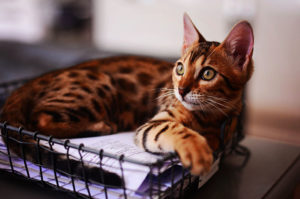DO I NEED TO TRAIN MY KITTEN TO USE A LITTER BOX?
At about 30-36 days of age, kittens leave the nest to search out a loose substrate / material for elimination. The kitten learns specific areas and substrates to use by observation of the queen (mother). Kittens dig in the substrate and bury their stools and urine.
IS THERE ANYTHING THAT I CAN DO TO AID THIS PROCESS?
Initially it is important that the kitten be confined to a small area with an appropriate sized litter box. As long as the kitty litter is the only loose material available, especially if it is the same that it was using from the breeder / previous home, very little effort should be required to litter box train your kitten / cat.
Like dogs, kittens will need to eliminate after they eat, after they sleep and after they play. At these times, place the kitten in its litter box and praise her for elimination. A kitten does not need to be confined continuously, but should be supervised to prevent accidents and frequently brought back to the appropriate elimination location.
WHAT TYPE OF LITTER MATERIAL SHOULD I USE?
There are many types of litters available. These include plain clay litters, recycled newspapers and fine ‘clumping’ litters. Some have added materials for odor control. Since the kitten will first start eliminating by following the cues of the mother, continuing with the same litter as used in the first home is helpful.
 WHAT SIZE AND TYPE OF LITTER BOX SHOULD I BUY
WHAT SIZE AND TYPE OF LITTER BOX SHOULD I BUY
The size of the box should be determined by the size of your cat.
- For a kitten, you may need a box with shorter sides for easier access
- As the kitten grows, a larger box will be more appropriate
- Some cats like privacy and owners prefer litter boxes with covers on them
- You need to be sure that your cat can negotiate the opening by stepping into it and that the cat is not too large.
WHERE SHOULD I PUT THE LITTER BOX
The litter box should be placed in a location that is easily accessed by the cat, yet out of the way. The cat should have some privacy and quiet to eliminate. Laundry and bathrooms are often used, but keep in mind that noise from household equipment (washing machine ect) is not disruptive and aversive to your cat.
Do not put food and water bowls right next to the litter box, after all we don’t eat next to our toilets.
If there are dogs in the home, the litter box should be located where the cat can eliminate without being bothered by them.
HOW OFTEN SHOULD I CLEAN THE LITTER BOX
One of THE most important factors in continued litter tray usage is cleanliness. Cats spend time each day making sure their coat, feet and face are clean. One can only assume they would like a clean place to eliminate.
- Fecal material should be removed on a daily basis.
- For clumping materials, daily or every other day removal of urine material is recommended.
- Remember, each cat is an individual, your cat may like more frequent cleaning of the litter box to maintain good usage patterns. Some cats dislike the odour of the cleansers used to clean litter boxes, so rinse the box thoroughly after each cleaning.
HOW MANY LITTER BOXES DO I NEED IN MY HOME?
The number of litter boxes needed depend on…
- The number of cats
- The size of the home
- The cats temperament
- Other pets in the home
If you have multiple cats or kittens, a number of boxes should be placed around the home, not side by side. Multiple boxes in multiple locations allow house -mates to avoid one another if they choose to do so.
Even for only one cat, two boxes around the home may be appropriate as come cats prefer to use one box for urine and one box for stools.
Some physical limitation may prevent a cat from climbing stairs and so a box in the location that the cat frequents is needed.
In general, there should be at least one litter box per cat, and some behaviourists advise one more box than the number of cats in the house.
WHAT IF THE KITTEN DOES NOT USE THE LITTER BOX?
Should your cat or kitten begin to eliminate in locations other than its litter box, first review the steps above.
- Is the litter in an appealing place?
- Is the box easily accessed by the cat?
- Is there anything in the area that may be a deterrent?
- Is the litter box being cleared often enough?
- Are the enough litter boxes for the number of cats?
To determine the most appealing litter for your cat, fill the same tray, or two similar trays with two different litters and see which one is used more frequently.
Next, determine the type of litter box the cat prefers, again side by side two different types of boxes (each filled with the preferred type of litter) and see which one is used most.
You can determine the cats preferred location by offering the preferred litter box with the preferred litter in two or more locations and again, see which one the cat visits more frequently.
If litter box problems persist, additional guidance and a consultation will be required. Call us today on 9878 3033 to speak to our experienced staff.





